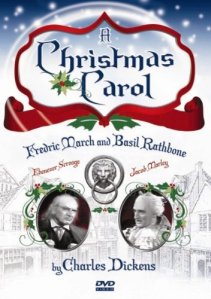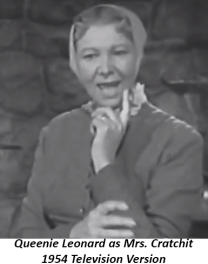 I move away from the animated versions (for now) and today I’m back to live-action A Christmas Carol interpretations.
I move away from the animated versions (for now) and today I’m back to live-action A Christmas Carol interpretations.
Since its early days, American television has been using ACC for holiday programming; sometimes pretty bad and occasionally very successful. Today is one of the surviving endeavors of early U.S. television from 1954 starring Frederic March and Basil Rathbone.
For me, the later half of the 1980’s was a great time for seeing and collecting various versions of A Christmas Carol. VHS was in its heyday and many of the ACC versions made available were being seen for the first time in years, sometimes decades. The 1954 U.S. television A Christmas Carol was another exciting prize when first released on VHS.
This presentation is not actually a “stand-alone” special or movie; it was a holiday season episode of a regular anthology/variety series called Shower of Stars on the CBS network. It was originally shown in color but only black and white kinescope copies have survived. When one watches the surviving B&W, the show’s announcer is heard proudly proclaiming it’s in color during the intro. This is far from being one of the “great” interpretations, but I seem to like it a bit more than many other folks. Of course, I need to approach this in context of its time and venue. My VHS version included the original commercials and show’s opening introducing the stars. The DVD version is a clean compilation taking out the intro and commercials. It’s interesting to view them both ways. The nostalgia junkie in me likes the old sponsor commercials but the version where they are cut out makes it feel like a slightly more serious presentation.
I think my personal reason for giving this venture some slack is because of the creative talent behind it. The adaptation and teleplay is by dramatist Maxwell Anderson. Anderson was a very good playwright in his time. He not only authored very successful plays (many turned into successful films) but was very adept at adapting other works to stage and/or screen (Key Largo, The Bad Seed), hence this teleplay for ACC. FYI, Frederic March starred in the film version of his play Mary of Scotland. Music and songs are by Bernard Herrmann. Herrmann was a very competent and successful composer, predominantly for films. He worked often with Orson Wells and Alfred Hitchcock. With an impressive list of film scores, one of his most recognizable works is the music for Psycho. Though minimal, the choreography is by two-time Tony award winning choreographer Donald Saddler.
With all the creative talent coupled with some top-notch performing talent, this had the potential to be a much better offering than what was finally presented.
Though the songs are original, few are actually performed by the characters. Many of the original songs are performed, quite well, by the insertion of carolers between scenes, played by a group known as Roger Wagner Chorale. This is the second time a television adaptation used a choir during its presentation. (It was also done in the unfortunate 1949 television version). There is a great piece right after Marley’s visit that is both beautiful and haunting.
The familiar story is performed. Frederic March gives a decent performance as Scrooge. There are a couple of instances of drawn out musical interludes where March gives non-vocal, emotive performances. To me, these are the only unsuitable aspects of his enactment. However, my belief is that poor staging and/or concept is really to blame for these mishaps and March was probably just following direction. A very interesting twist is done by March after he delivers the familiar “…they had better do it and decrease the surplus population” line. Immediately after its delivery, he cocks his head to the side with a nasty smile and short, evil chuckle as if happily picturing the event while being pleased with himself at the same time. Quite a nasty fellow!
Basil Rathbone gives a good Jacob Marley – not one of the best, but better than some others. He obviously takes the role seriously as a dramatic vehicle. When I sat to watch this for the first time on my original VHS copy, there was a small, anticipatory fear that this would make March and Rathbone participate in some ill-conceived song or production number. Thanks be that doesn’t happen and they are wisely regulated to providing the dramatics. However, after this production, Basil Rathbone did appear in the next made for U.S. television musical version, The Stingiest Man in Town, as Scrooge!
I have always really liked Ray Middleton, particularly from Man of La Mancha and 1776 (musical geek that I am). He has one of the two dual roles in this version. Middleton doubles as Scrooge’s nephew, Fred, and the Ghost of Christmas Present. As much as I like him, he’s not well suited for the part of Fred. He fairs much better as the Ghost of Christmas Present. However, the drawbacks to this conception of the Present Ghost I don’t blame Middleton for. First, this is one of those times the Present Ghost’s costume is a total divergence from Dickens’ description. Second, the outfit is not at all flattering to a man with Middleton’s build. I think it would very much have better suited him to be in a more traditional Ghost of Christmas Present costume…and with a beard!
Sally Fraser tackles the other dual role as The Ghost of Christmas Past and Belle. I’m not familiar with this actress. She’s attractive and has a pretty singing voice with a decent song. (But it turns out her voice is dubbed by the great Marilyn Horne!) It’s always seemed to me that in musical adaptations of ACC, Belle usually gets one of the best songs. In this show here song turns into a duet.
The dual roles have a loose logic to them. Their intention is meant to be noticed by Scrooge. The Ghost of Christmas Past appears as his past love, Belle, and he comments on the “resemblance.” The Ghost of Christmas Present should then be fittingly represented by his Christmas loving nephew, Fred, whom he had seen just hours earlier. Scrooge again comments on the resemblance. It feels like it takes its lead from the MGM adaptation of The Wizard of OZ. If I’m not mistaken, I believe this is the first version to present dual roles with the ghosts and other characters.
Featured actor Bob Sweeney is so-so as Bob Cratchit. For such an important part in the story, it’s small and his performance is uninspired. Sweeney was a very active television actor during his career but he’s not memorable here.
 As I did in a previous post, I’ll make a small note of interest here to Queenie Leonard, the actress playing Mrs. Cratchit. She was an English born actress and cabaret performer. She had a very respectable and varied career as a performer. This is the second time she played Mrs. Crarchit in a television production. She first played the role in the bland 1949 television version of The Christmas Carol. Though I never heard her sing, it’s too bad Leonard wasn’t given some singing in this musical imagining as she was an experienced singer.
As I did in a previous post, I’ll make a small note of interest here to Queenie Leonard, the actress playing Mrs. Cratchit. She was an English born actress and cabaret performer. She had a very respectable and varied career as a performer. This is the second time she played Mrs. Crarchit in a television production. She first played the role in the bland 1949 television version of The Christmas Carol. Though I never heard her sing, it’s too bad Leonard wasn’t given some singing in this musical imagining as she was an experienced singer.
Alas, there are some big groans along the way. At least the attempts at English accents from the non-English actors, even if poorly done, outweigh the Americans that don’t even try…meaning of course we still have home-turf nasalings here. This becomes particularly bad during the visit to the past at the Fezziwig party. Here, we have Frederic March as old Scrooge in his natural English voice while the young Scrooge is pure American in tone. Seriously? Better still, there is an actress with one line at the party where I’m absolutely positive she says it in a Southern accent!
Unique
There are a few original bits here but I’ll stick with one. The most unique offering, usually criticized, is the Ghost of Christmas Yet to Come. In one of the biggest ever deviations for a traditional version, the 3rd Ghost appears as a crow (or raven)! There could be much speculation as to the reason or any intended symbolism with this concept, but for now I’ll leave that to someone else. However, the crow just doesn’t come out of anywhere as the ghost. The crow is seen early in the show if one pays attention. It is first seen as a stuffed and mounted perched bird on Scrooge’s table in his room. During the Ghost of Christmas Present’s musical number, when first appearing to Scrooge, he picks up the stuffed bird and breathes life into it; the resurrected bird then flies out the bedroom window as the shutters magically close behind it. The next time Scrooge sees the bird, it is immediately after the Ghost of the Christmas Present leaves. Scrooge’s attention is then drawn to a window and notices with surprise the bird on a tree branch and looking at him as his final visitor.
Missing
There’s much more that can be listed, but these are the larger or more obvious omissions from this version:
- Phantom hearse
- Wandering spirits
- Young Scrooge at school flashback
- Fan (Scrooge’s sister)
- Ignorance & Want
- Most of the future events with the Christmas Yet to Come segment
Silly
The silliest thing for me in this version is the prosthetic nose Frederic March wears as Scrooge. It’s completely unnecessary in assisting March to do the character and I often get distracted to what’s going on by focusing on it. It’s a true “what were they thinking?” bit.
Before Being Famous
The late Bonnie Franklin, most well known for the show One Day at a Time, appears as one of the Cratchit chidren.
Pingback: The Stingiest Man in Town, 1956 | 25 Days of A Christmas Carol
Pingback: A Christmas Carol: The Musical, 2004 | 25 Days of A Christmas Carol